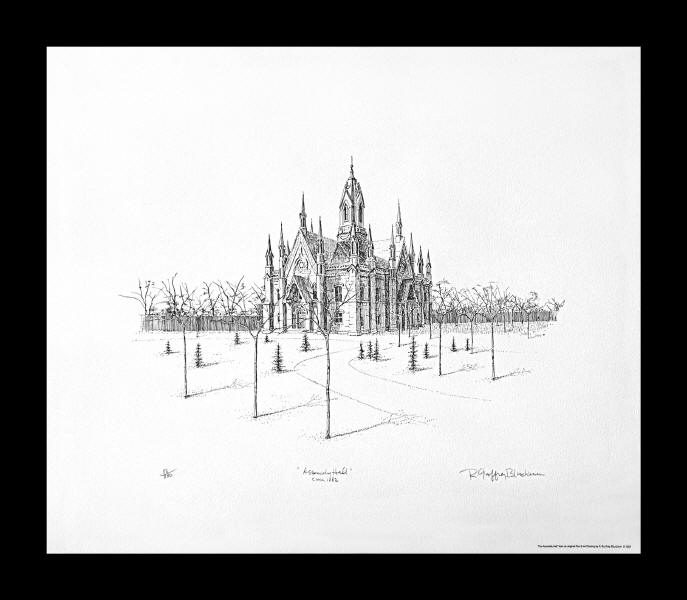| Description | Size | Price |
| Original Pen and Ink Drawing |
19 x 22 in (48 x 81.3 cm) | NFS |
| Original Offset Lithograph | 9 x 22 in (48 x 81.3 cm) | inquire |
| (Artist's Proof) | 9 x 22 in (48 x 81.3 cm) | inquire |
contact: rgeoffrey@rgeoffrey.com
| Numbered Edition: 300 - Artist's Proofs (A/P): 50 - Published: September 1990 |
"The Assembly Hall"
"
About the art:
The Limited Edition Original Offset Lithograph entitled "The Assembly Hall" was created from an original pen and ink drawing by artist, R. Geoffrey Blackburn. It depicts a morning view of the newly landscaped Mormon Assembly Hall circa 1882. This is the only work depicting an LDS subject by this artist.
About the building:*
Located on Temple Square, in Salt Lake City, Utah, the Assembly Hall was designed by architect Obed Taylor and built by Henry Grow. Construction began in September 1877 and was completed in 1880. The building was dedicated January 8,1882. The first public meeting was held April 4,1882.
The Assembly Hall was built to serve as a meetinghouse for LDS Church members of the Salt Lake Stake. It has been used for religious services, conferences, lectures, concerts, funerals and Tabernacle overflow. It seats up to 1500 people.
Built of granite rejected for use in the Temple, the Assembly Hall is of the Semi-Gothic style of architecture. The building's dimensions are 68' x 120', with the central tower rising 130' above the ground. The original columns and benches (still there), were finished to simulate marble and oak respectively. There are over 800 speakers under the benches, timed so that all listeners receive sound simultaneously. Originally, all the windows were clear glass. Installation of the stained glass windows was begun in 1891.
One of the Assembly Hall's most unique attributes is the distinctive six-pointed star displayed over each of the four entrances to the building. The possible symbolism behind this design has been the subject of much speculation. In one theory, the star's six points represent the six days of toil, and the circle represents the seventh day of rest. In another theory, extensive Masonic influence is claimed. Perhaps the most widely discussed idea is that the star may have been symbolically connected to the six-pointed Jewish Star of David. Research, however, has failed to reveal a conclusive link between the Assembly Hall star design and any of these outside influences.
What is known is that architect Obed Taylor had previously used the popular circle and star design, a five-pointed star, on at least one other building, the l8th Ward House across from the Utah State Capitol. Adding a sixth point to the Assemble Hall star may have been purely an aesthetic decision.
* Historical data provided by the LDS Church History Library and LDS Visitors Center.
R. Geoffrey Blackburn


 Blackburn Studios
Blackburn Studios